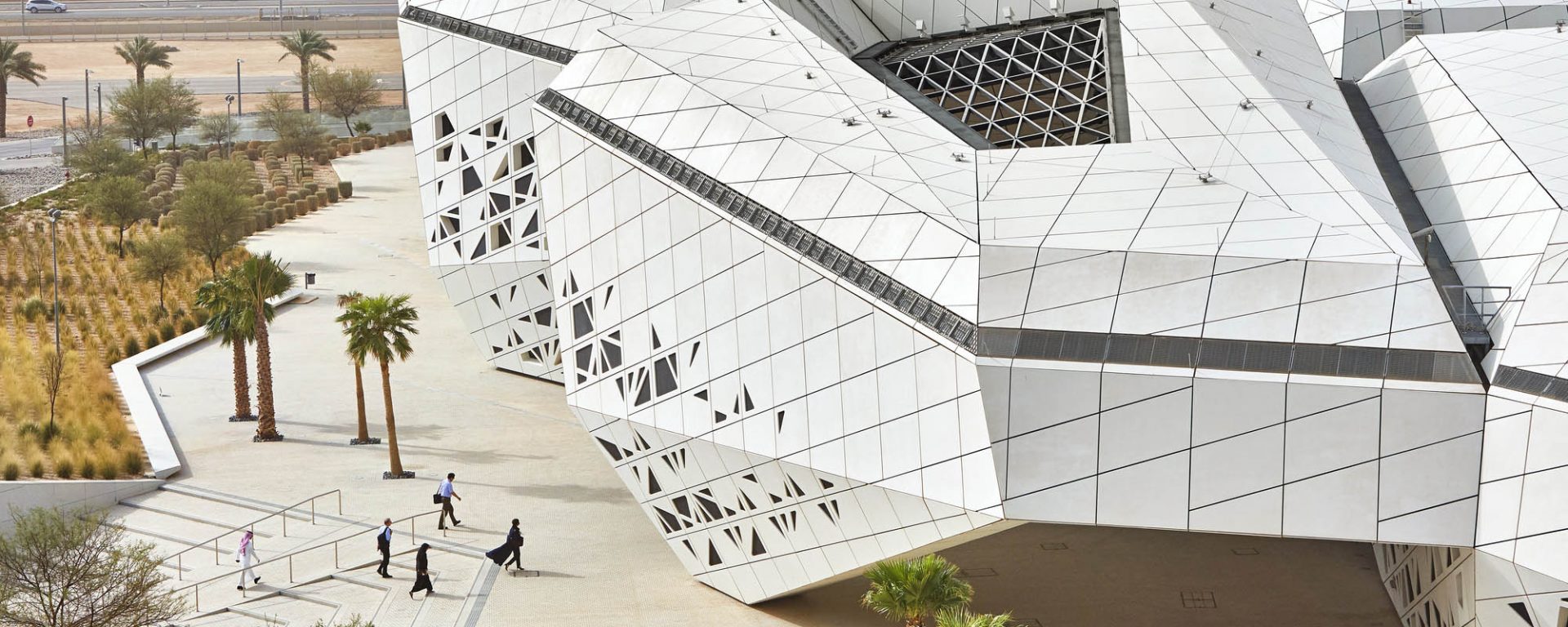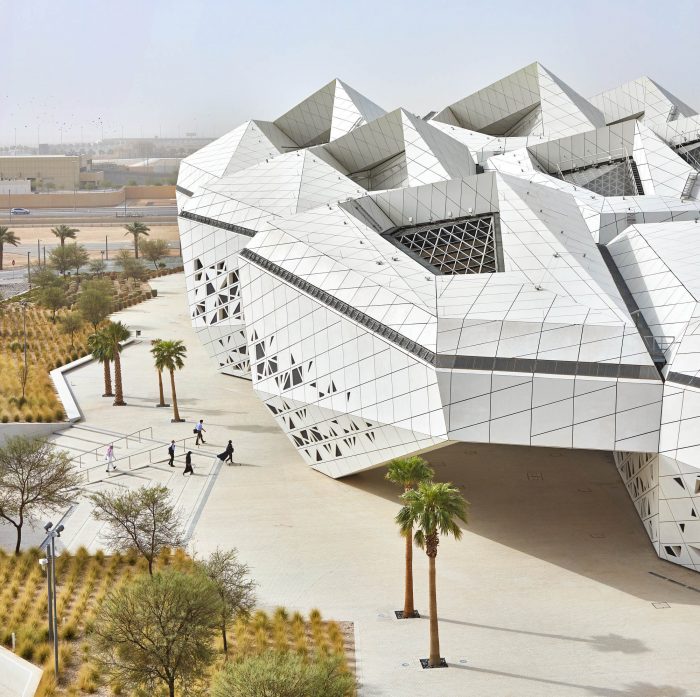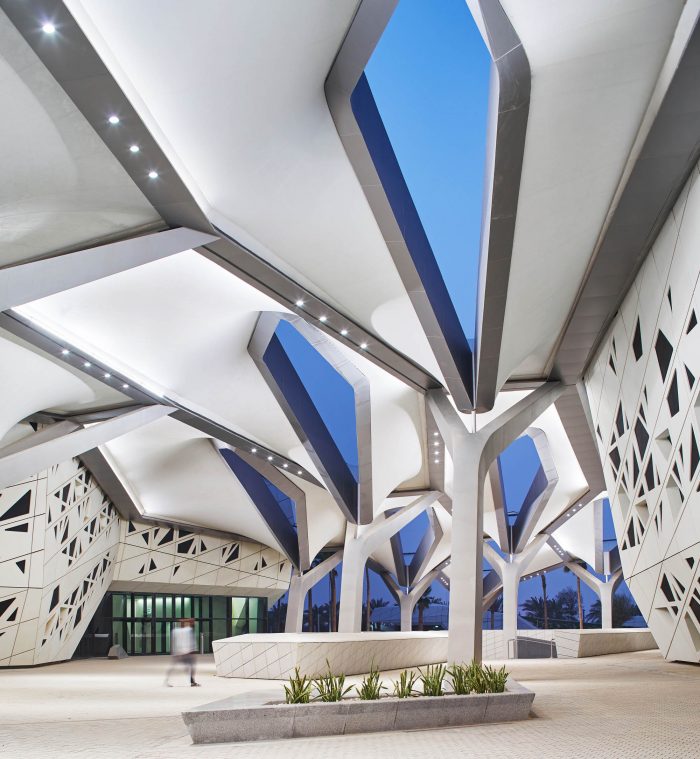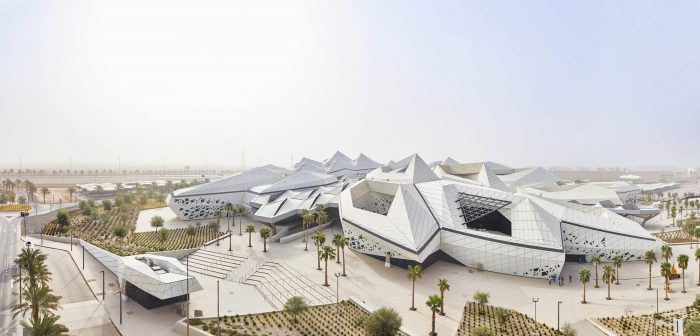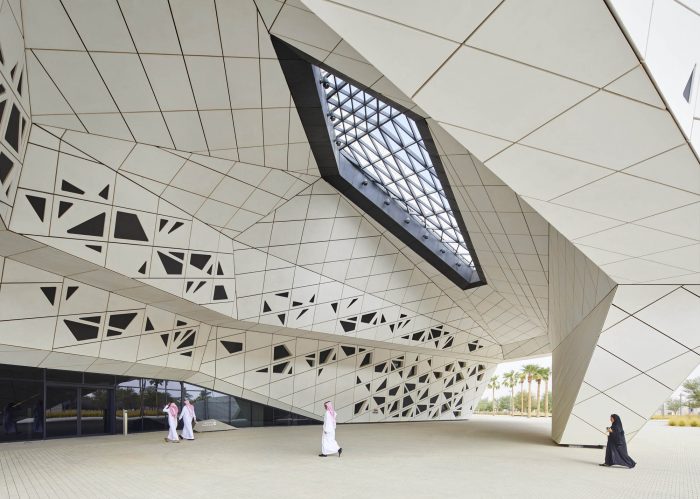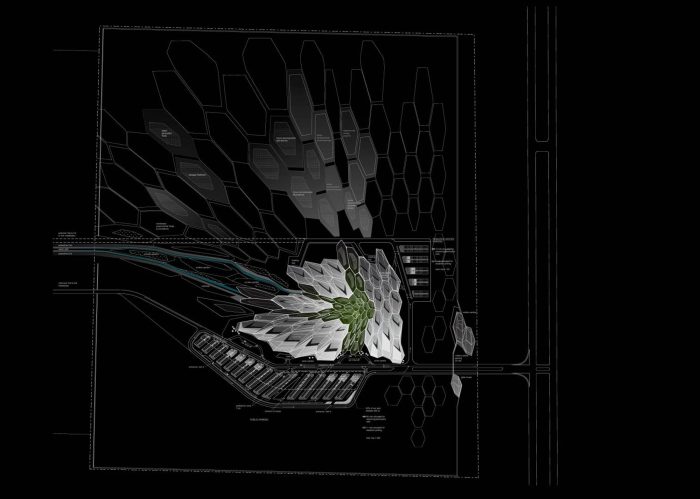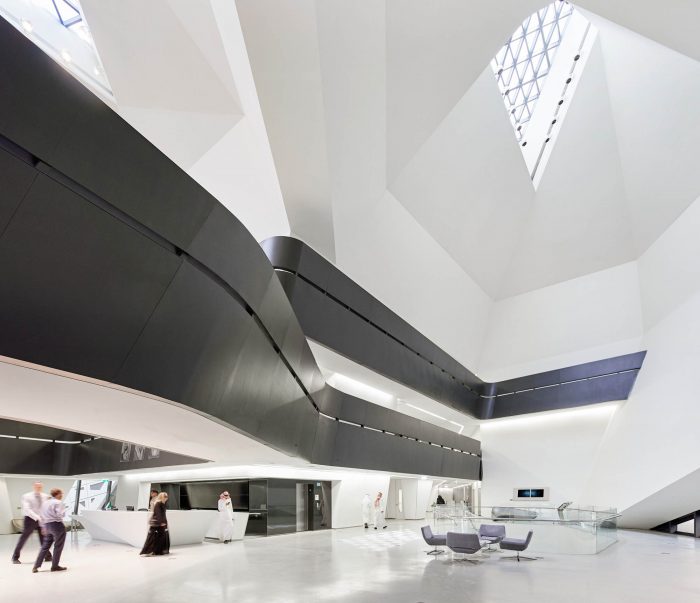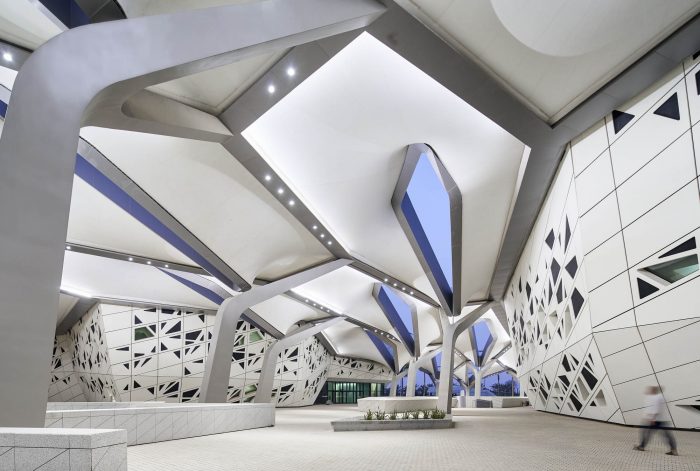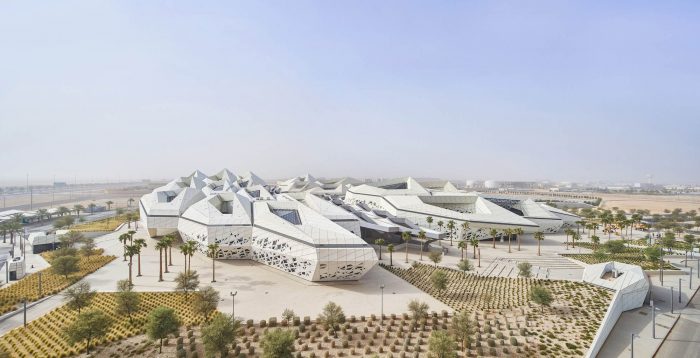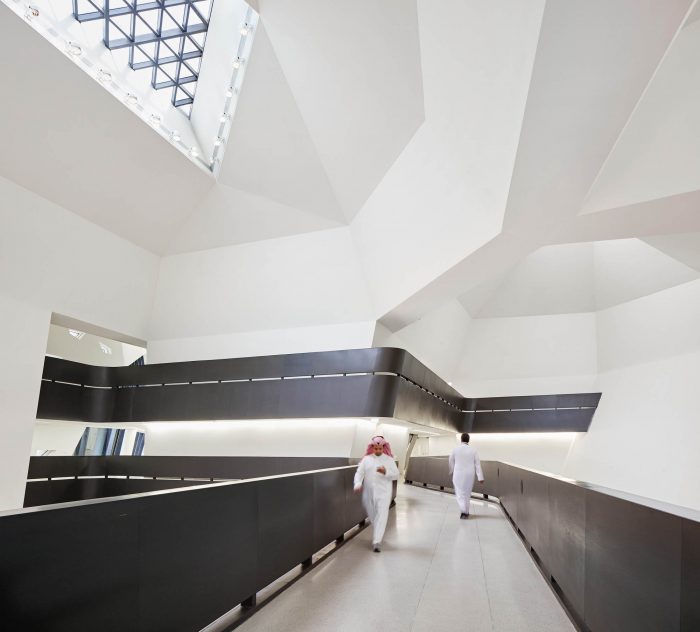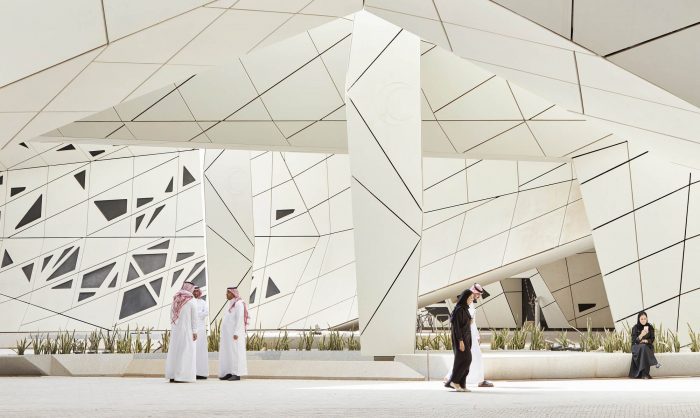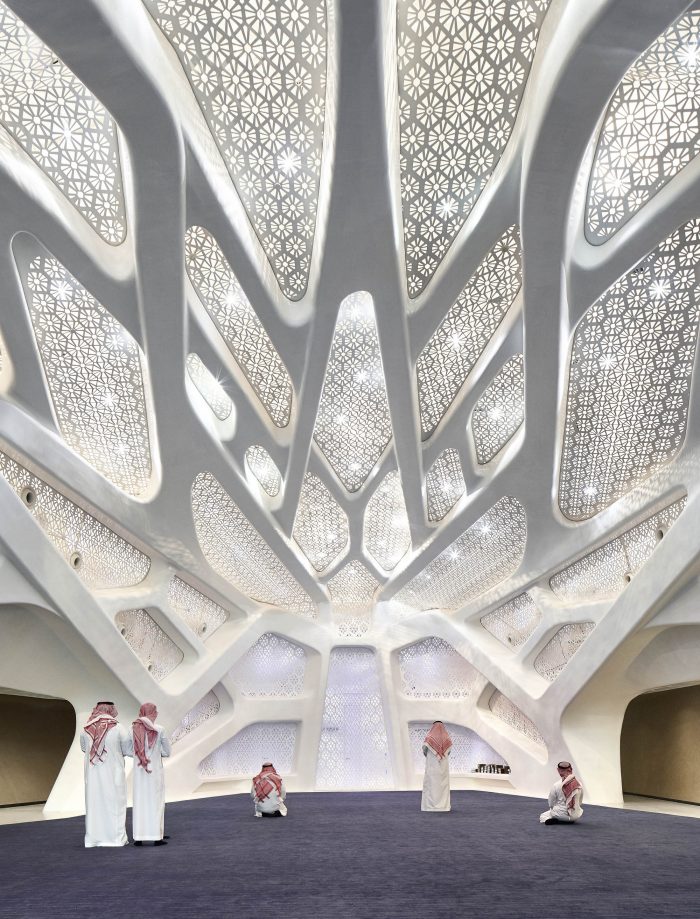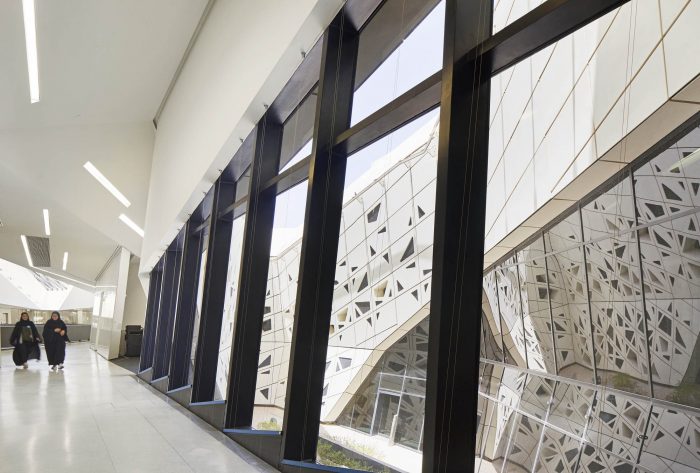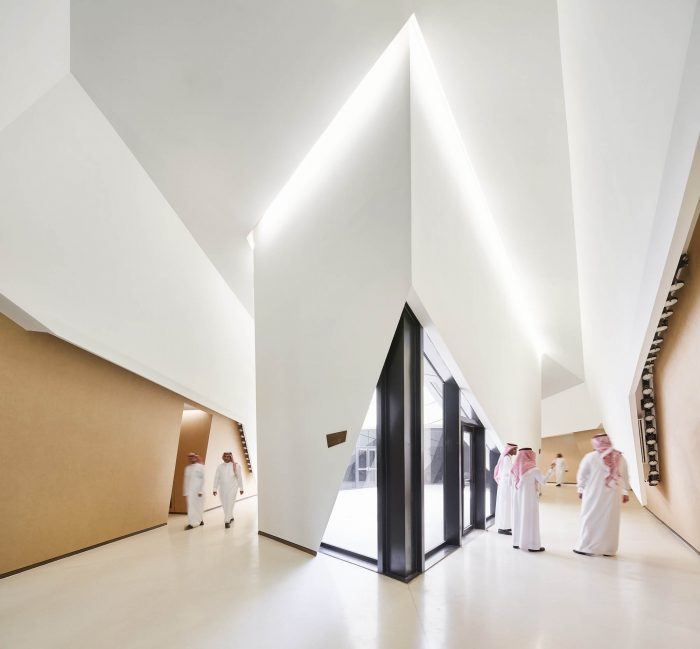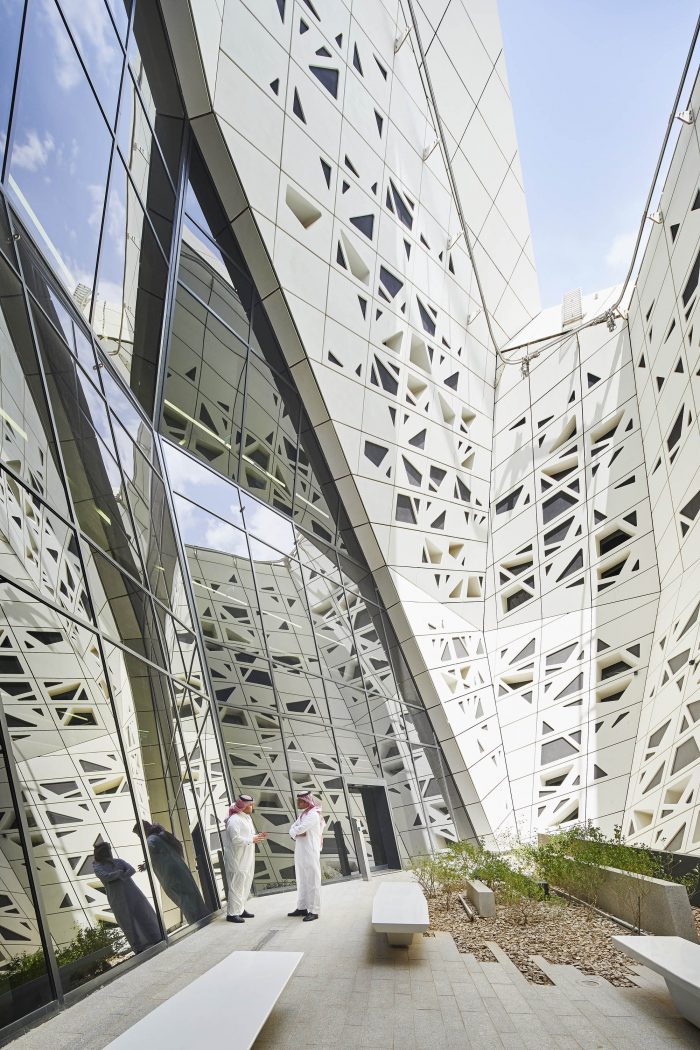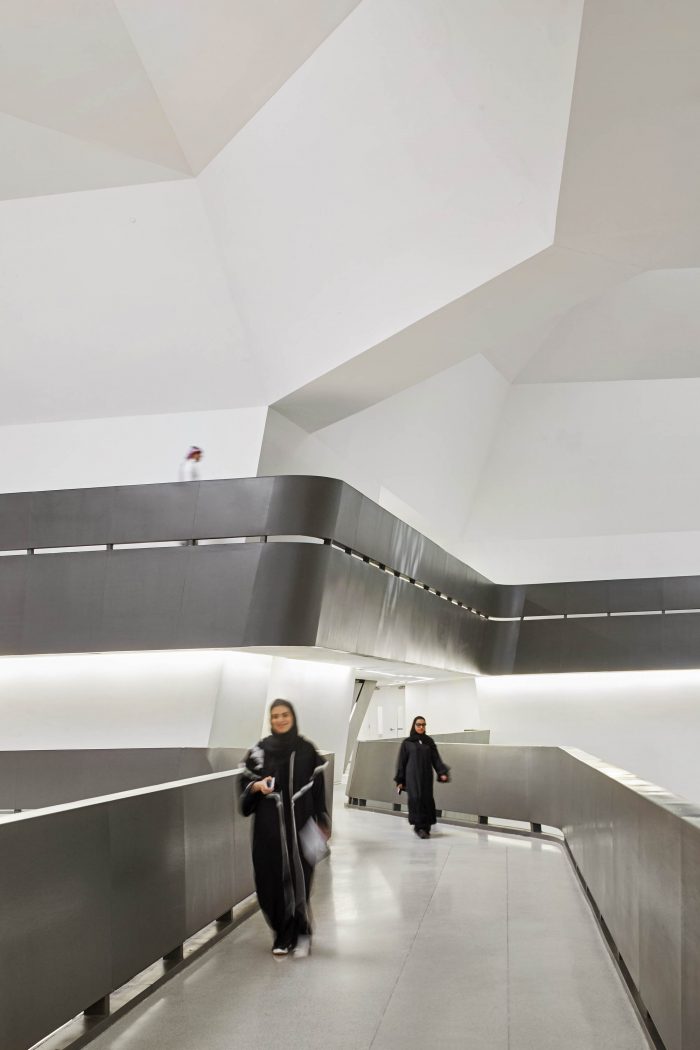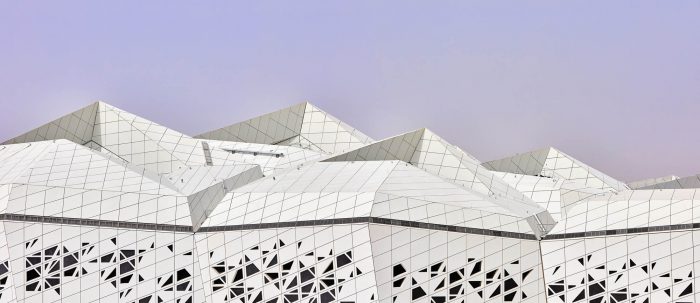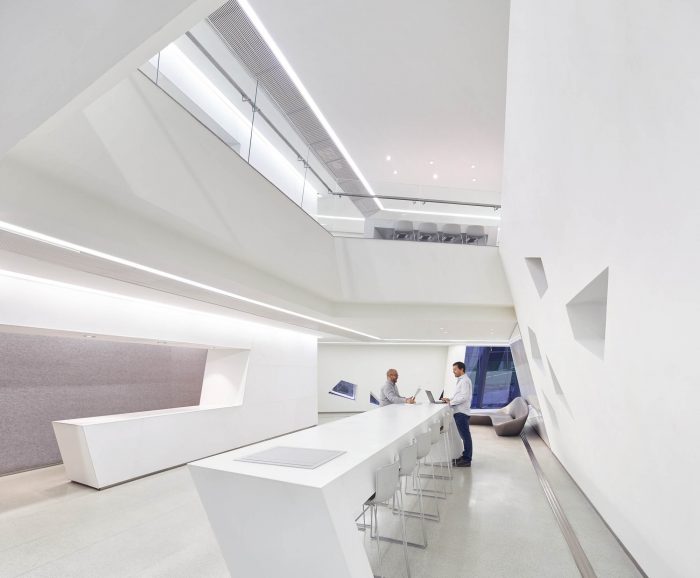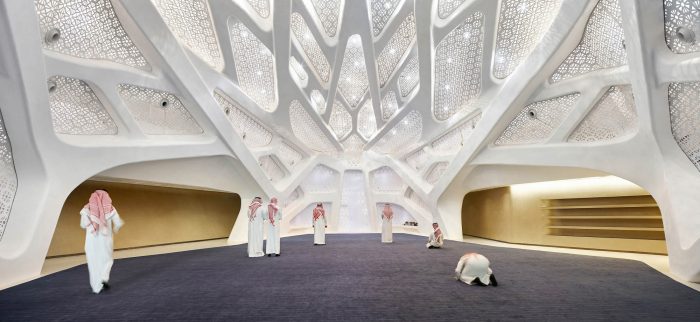阿卜杜拉国王石油研究中心是一个非营利机构,对有助于最有效地利用能源以在全球提供社会福利的政策进行独立研究。
KAPSARC (King Abdullah Petroleum Studies and Research Centre) is a non-profit institution for independent research into policies that contribute to the most effective use of energy to provide social wellbeing across the globe.
KAPSARC制定政策和经济框架,以减少环境影响和能源供应的总体成本,并提供基于技术的实用解决方案,以更有效地利用能源。
KAPSARC develops policies and economic frameworks that reduce the environmental impact and overall costs of energy supply and enable practical technology-based solutions to use energy more efficiently.
KAPSARC与国际研究中心、公共政策组织、世界范围内的政府机构和全球工业界合作,将来自世界各地的顶尖专家聚集在一起,共同应对能源方面的挑战;免费分享其知识、见解和分析框架。
Collaborating with international research centres, public policy organisations, worldwide government institutions and global industry, KAPSARC brings together leading experts from around the world to tackle energy challenges; freely sharing its knowledge, insights and analytical frameworks.
70,000平方米的KAPSARC校园包括五座建筑:能源知识中心、能源计算机中心、带展厅和300座礼堂的会议中心、藏有10万册档案的研究图书馆和校园内的祈祷场所Musalla。
The 70,000m² KAPSARC campus incorporates five buildings: the Energy Knowledge Centre; the Energy Computer Centre; a Conference Centre with exhibition hall and 300-seat auditorium; a Research Library with archives for 100,000 volumes; and the Musalla, an inspirational place for prayer within the campus.
KAPSARC的设计以坚实的技术和环境考虑为核心,将校园的五个元素拉成一个统一的整体。ZHA是第一个获得美国绿色建筑委员会LEED铂金级认证的项目,该中心的设计针对利雅得高原的环境条件,最大限度地减少能源和资源消耗。
KAPSARC’s design has solid technical and environmental considerations at its heart, drawing the five elements of the campus into a unified whole. ZHA’s first project to be awarded LEED Platinum certification by the US Green Building Council, the centre is designed in response to the environmental conditions of the Riyadh Plateau to minimise energy and resource consumption.
设计的主要组织策略是一个蜂窝式、部分模块化的系统,将不同的部门建筑整合为一个整体,公共空间相互连接。
The primary organising strategy of the design is a cellular, partially modular system that integrates different departmental buildings as a single ensemble with interconnecting public spaces.
六角棱柱状的蜂窝结构在给定的体积内使用最少的材料创造出一个单元格。这种结构和组织原则决定了KAPSARC的构成是一个从沙漠景观中出现的结晶形式的综合体,不断演化以最好地应对环境条件和内部方案要求。蜂窝状的网格被压缩到中轴线上,作为西边自然瓦迪的延伸。
Hexagonal prismatic honeycomb structures use the least material to create a lattice of cells within a given volume. This structural and organisational principle determined KAPSARC’s composition as an amalgamation of crystalline forms that emerges from the desert landscape, evolving to best respond to the environmental conditions and internal programme requirements. The honeycomb grid is compressed towards its central axis as an extension of the natural wadi that runs to the west.
研究中心的本质是一个前瞻性的机构,KAPSARC的建筑也着眼于未来的形式构成,可以在不影响中心的视觉特征的情况下进行扩展或调整。
A research centre is by its very nature a forward-looking institution and KAPSARC’s architecture also looks to the future with a formal composition that can be expanded or adapted without compromising the centre’s visual character.
模块化的设计产生了一致的组织,空间和结构策略,推动了计划的所有元素。六边形单元的六个面与只有四个面的矩形单元相比,也提供了更多的机会来增加连接性。
The modular design generates consistent organisational, spatial and structural strategies that drive all elements of the plan. The six sides of the hexagonal cells also offer greater opportunities for increased connectivity when compared to rectangular cells with only four sides.
KAPSARC的五座建筑在大小和组织上都有所不同,以最适合它们的用途。每个建筑都被划分为其组成部分的功能,并可以调整以应对要求或工作方法的变化。通过扩展KAPSARC的蜂巢式格局,可以很容易地引入额外的单元,以适应未来研究园区的扩展。
KAPSARC’s five buildings differ in size and organisation to best suit their use. Each building is divided into its component functions and can be adapted to respond to changes in requirements or working methods. Additional cells can readily be introduced by extending KAPSARC’s honeycomb grid for future expansion of the research campus.
KAPSARC建筑的具体安排和形式有助于缓解利雅得高原的强光和热量。
园区的建筑围绕着一个大的公共庭院,由林立的钢柱支撑的雨棚遮挡。KAPSARC校园向北和向西开放,为南边刺眼的阳光提供了一个坚实的保护外壳,鼓励北边的盛行风在温润的月份为庭院降温,并促进与未来校园向北扩展的联系,以及与西边的研究人员居住社区建立联系。
The specific arrangement and form of KAPSARC’s buildings contribute to softening the strong light and heat of the Riyadh Plateau.
The buildings of the campus surround a large public courtyard shaded by canopies supported from a forest of crafted steel columns. Presenting a solid, protecting shell to the harsh sunlight from the south, the KAPSARC campus opens to north and west; encouraging prevailing winds from the north to cool the courtyard during temperate months and facilitating connections with any future expansion of the campus to the north, as well as creating connections with the researcher’s residential community to the west.
园区内的每一栋建筑都是通过这个中央公共庭院进入的,该庭院在温带季节也是会议空间和建筑之间的联系。地下通道也连接着园区内的主要建筑,供一年中最炎热的时候使用。
KAPSARC的建筑外部有坚固的保护壳,可以抵御极端天气的影响,内部是多孔的。每栋建筑内战略性的六边形单元都是开放的,以创造一系列遮蔽的庭院,将柔和控制的日光引入室内。
Privileging the pedestrian, each of the buildings within the campus is entered through this central public courtyard that also serves as a meeting space and link between buildings during temperate seasons. An underground link also connects the main buildings on the campus for use at the hottest times of the year.
With its strong, protective shell on the exterior that shields from the extremes in weather, KAPSARC’s architecture is porous within. Specific hexagonal cells strategically located within each building are left open to create a series of sheltered courtyards that bring softly-controlled daylight into the interior.
根据日照和风向条件,棱柱形建筑单元的晶状体向南、向西和向东增高,以遮挡内部空间的阳光直射,而内部的庭院则向北和西北方向,将间接的阳光引入下面的空间。
‘捕风器’集成在每个庭院南侧的屋顶轮廓内,捕捉来自北方的盛行风,冷却每个庭院。
Orientated for the sun and wind conditions, the crystalline forms of the prismatic architectural cells gain in height towards the south, west, and east to shield internal spaces from direct sunlight, while the courtyards within are oriented to the north and northwest to bring indirect sunlight into the spaces below.
‘Wind-catchers’ integrated within the roof profiles on the southern sides of each courtyard catch the prevailing winds from the north, cooling each courtyard.
KAPSARC的建筑提高了透明度,并鼓励研究人员和参观者之间的积极交流。通过战略性地抵消楼板,整个中心的空间分层效果被创造出来,以提供上下楼层的景观;在公共区域的楼层之间提供透明度,设计成集体区域,供研究人员非正式地会面和交流意见。安全区域和需要隐私的房间位于每栋建筑的楼板重叠的区域内。
KAPSARC’s architecture promotes transparency and encourages an active exchange between researchers and visitors. By strategically off-setting floorplates, spatial layering effects are created throughout the centre to provide views to the floors above and below; offering transparency between floors in public areas designed as collective zones for researchers to meet informally and exchange ideas. Secure areas and rooms requiring privacy are located within areas of each building where floorplates overlap.
KAPSARC通过被动式和主动式解决方案的应用,获得了美国绿色建筑委员会(USGBC)的LEED铂金级认证,其中包括。
通过KAPSARC的建筑体量和朝向、外立面优化、系统选择和位于南向会议中心屋顶的太阳能光伏阵列,实现了45%的节能效果(与ASHRAE基线标准相比)。
KAPSARC的所有饮用水都在现场回收和再利用,100%的灌溉用水来自非饮用水源。
KAPSARC40%的建筑材料来自500英里以内的地方,30%的材料采用再生材料。
98%的木材都获得森林管理委员会(FSC)认证。
4,000吨的废物被分离,并从填埋场转移。
KAPSARC was awarded LEED Platinum certification from the United States Green Building Council (USGBC) through its application of passive and active solutions including:
A 45% reduction in energy performance (compared to the ASHRAE baseline standards) achived via KAPSARC’s building massing and orientation, façade optimisation, system selection and the solar PV array located on the roof of the south-facing Conference Centre with a capacity of 5,000MWh/year.
All KAPSARC’s potable water is recycled and reused on site and 100% of irrigation water is from non-potable sources.
40% of KAPSARC’s construction materials have been sourced from within 500 miles, and 30% of materials made with recycled content.
98% of all wood certified by the Forest Stewardship Council (FSC).
4,000 tonnes of waste separated and diverted from landfill.
KAPSARC还被霍尼韦尔智能建筑奖评为沙特阿拉伯 “最聪明 “的建筑。根据包括环境可持续性、安全和生产力在内的标准,KAPSARC在所有三个类别中都获得了突出的分数。
KAPSARC has also been named Saudi Arabia’s ‘smartest’ building in the Honeywell Smart Building Awards programme. Based on criteria that include environmental sustainability, safety and productivity, KAPSARC received outstanding scores across all three categories.
建筑师:Zaha Hadid Architects
面积:70000 m²
年份:2017年
摄影师:Hufton + Crow
项目现场团队:John Simpson (现场助理), Alejandro Diaz, Anas Younes, Annarita Papeschi, Aritz Moriones, Ayca Vural Cutts, Carlos Parraga-Botero, Javier Rueda, Malgorzata Kowalczyk, Michal Wojtkiewicz, Monika Bilska, Sara Criscenti, Stella Dourtme
项目负责人:Fabian Hecker(研究中心)、Michael Powers(会议中心)、Brian Dale / Henning Hansen(图书馆)、Fulvio Wirz(Musalla / IT中心)、Elizabeth Bishop(外墙/二维文件)、Saleem A.Jalil / Maria Rodero (总体规划), Lisamarie Ambia/Judith Wahle (室内装修), Bozana Komljenovic (二维文档), John Randle (规格), John Szlachta (三维文档协调员)
项目组: Adrian Krezlik, Alexander Palacio, Amdad Chowdhury, Amit Gupta, Andres Arias Madrid, Britta Knobel, Camiel Weijenberg, Carine Posner, Claire Cahill, Claudia Glas-Dorner, DaChun Lin, Daniel Fiser, Daniel Toumine, David Doody, David Seeland, Deniz Manisali, Elizabeth Keenan, Evan Erlebacher, Fernanda Mugnaini, Garin O’Aivazian, Giorgio Radojkovic, Inês Fontoura, Jaimie-Lee Haggerty, Jeremy Tymms, Julian Jones, Jwalant Mahadevwala, Lauren Barclay, Lauren Mishkind, Mariagrazia Lanza, Melike Altinisik, Michael Grau, Michael McNamara, Mimi Halova, Mohammad-Ali Mirzaei, Mohammed Reshdan, Muriel Boselli, MyungHo Lee, Nahed Jawad, Natacha Viveiros, Navvab Taylor, Neil Vyas, Nicola McConnell, Pedro Sanchez, Prashanth Sridharan, Roxana Rakhshani, Saahil Parikh, Sara Saleh, Seda Zirek, Shaju Nanukuttan, Shaun Farrell, Sophie Davison, Sophie Le Bienvenu, Stefan Brabetz, Steve Rea, Suryansh Chandra, Talenia Phua Gajardo, Theodor Wender, Yu Du.
竞赛设计团队:Lisamarie Ambia、Monika Bilska、Martin Krcha、Maren Klasing、Kelly Lee、Johannes Schafelner、Judith Schafelner、Ebru Simsek、Judith Wahle、Hee Seung Lee、Clara Martins、Anat Stern Daniel Fiser;Thomas Sonder、Kristina Simkeviciute、Talenia Phua Gajardo、Erhan Patat、Dawna Houchin、Jwalant Mahadevwala
工程:Arup
室内设计:Woods Bagot
景观设计:GROSS.MAX
照明设计:Office for Visual Interaction
餐饮和厨房设计:Eastern Quay and GWP
展览设计:Event
作品:International Art Consultants
品牌和标识:Elmwood and Bright
3d图库咨询:Tribal Cost Consulting and Design
项目管理:Davis Langdon
建筑设计:Zaha Hadid, Patrik Schumacher
项目总监:Lars Teichmann, Charles Walker
设计总监:DaeWha Kang
城市:Riyadh
国家:沙特阿拉伯
Architects: Zaha Hadid Architects
Area: 70000 m²
Year: 2017
Photographs:Hufton + Crow
Project Site Team:John Simpson (Site Associate), Alejandro Diaz, Anas Younes, Annarita Papeschi, Aritz Moriones, Ayca Vural Cutts, Carlos Parraga-Botero, Javier Rueda, Malgorzata Kowalczyk, Michal Wojtkiewicz, Monika Bilska, Sara Criscenti, Stella Dourtme
Project Leaders:Fabian Hecker (Research Center), Michael Powers (Conference Center), Brian Dale / Henning Hansen (Library), Fulvio Wirz (Musalla / IT Center), Elizabeth Bishop (Facades/2d Documentation), Saleem A. Jalil / Maria Rodero (Master Plan), Lisamarie Ambia/Judith Wahle (Interiors), Bozana Komljenovic (2d Documentation), John Randle (Specifications), John Szlachta (3d Documentation Coordinator)
Project Team:Adrian Krezlik, Alexander Palacio, Amdad Chowdhury, Amit Gupta, Andres Arias Madrid, Britta Knobel, Camiel Weijenberg, Carine Posner, Claire Cahill, Claudia Glas-Dorner, DaChun Lin, Daniel Fiser, Daniel Toumine, David Doody, David Seeland, Deniz Manisali, Elizabeth Keenan, Evan Erlebacher, Fernanda Mugnaini, Garin O’Aivazian, Giorgio Radojkovic, Inês Fontoura, Jaimie-Lee Haggerty, Jeremy Tymms, Julian Jones, Jwalant Mahadevwala, Lauren Barclay, Lauren Mishkind, Mariagrazia Lanza, Melike Altinisik, Michael Grau, Michael McNamara, Mimi Halova, MohammadAli Mirzaei, Mohammed Reshdan, Muriel Boselli, MyungHo Lee, Nahed Jawad, Natacha Viveiros, Navvab Taylor, Neil Vyas, Nicola McConnell, Pedro Sanchez, Prashanth Sridharan, Roxana Rakhshani, Saahil Parikh, Sara Saleh, Seda Zirek, Shaju Nanukuttan, Shaun Farrell, Sophie Davison, Sophie Le Bienvenu, Stefan Brabetz, Steve Rea, Suryansh Chandra, Talenia Phua Gajardo, Theodor Wender, Yu Du
Competition Design Team:Lisamarie Ambia, Monika Bilska, Martin Krcha, Maren Klasing, Kelly Lee, Johannes Schafelner, Judith Schafelner, Ebru Simsek, Judith Wahle, Hee Seung Lee, Clara Martins, Anat Stern Daniel Fiser; Thomas Sonder, Kristina Simkeviciute, Talenia Phua Gajardo, Erhan Patat, Dawna Houchin, Jwalant Mahadevwala
Engineering:Arup
Interior Design:Woods Bagot
Landscape Design:GROSS.MAX
Lighting Design:Office for Visual Interaction
Catering And Kitchen Design:Eastern Quay and GWP
Exhibition Design:Event
Artwork:International Art Consultants
Branding And Signage:Elmwood and Bright
3d Library Consulting:Tribal Cost Consulting and Design
Project Management:Davis Langdon
Architectural Design:Zaha Hadid, Patrik Schumacher
Project Directors:Lars Teichmann, Charles Walker
Design Director:DaeWha Kang
City:Riyadh
Country:Saudi Arabia

